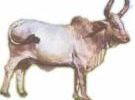Because people drink the cow's milk, the Vedas consider the cow one of the mothers of human society. "The blood of the cow is very nutritious," Çréla Prabhupäda said, "but civilized men utilize it in the form of milk." The bull, who helps produce grains by tilling the fields, is considered the father of human society. The interdependance of man and the bull and cow is a perfect example of the harmony of nature, as ordained by Kåñëa Himself. Furthermore, both these animals are considered valuable because from them come panca-gavya, five pure substances, namely milk, yogurt, ghee, cow dung and cow urine. All these substances are required in Vedic ceremonies. Even the cows dung and urine are antiseptic and fit for sacrificial offerings and medicine. Thus, in Bhagavad-gétä Kåñëa personally speaks of go-raksyam, cow protection. Unfortunately, in our "advanced" civilization, people neglect spiritual knowledge and promote cow-killing on a massive scale. "It is to be understood then," writes Çréla Prabhupäda, "that human society is advancing in the wrong direction and is clearing the path to its own condemnation."
In the matter of protecting cows, some meat-eaters will protest, but in answer to them we say that since Kåñëa gives stress to cow protection, those who are inclined to eat meat, despite all reasonable arguments to the contrary, should eat the flesh of less important animals like hogs, poultry, or fish, but they should not kill cows. The Vedas state that anyone implicated in the killing of a cow will have to take as many rebirths in the material world as there are hairs on the back of the cow. And the Vedas are not the only scriptures to condemn cow-killing. In the Bible (66:3) Isaiah declares, "He that killeth an ox is as he that killeth a man."
On the whole, meat-eating is not completely forbidden in Vedic culture: a particular class of people is allowed to eat meat according to various circumstances and injunctions. Killing cows, however, is strictly forbidden to everyone. Çréla Prabhupäda proposed that if someone must eat beef, then he should eat the carcasses of cows that die naturally. After an initial period of apparent scarcity, there will be plenty of carcasses to go around.
The most important reason for protecting cows is that Kåñëa loves them. The Vedic scriptures tell us that in Kåñëa-loka, Lord Kåñëa's eternal abode in the spiritual sky, there are cows called surabhi, which the Lord Himself takes care of. Kåñëa's abode is also called Goloka, or the planet of the cows.
Five thousand years ago, when Lord Kåñëa appeared in this world, He played as a cowherd boy in the North Indian village of Vrindavana and showed His affection for cows. His childhood pastimes revolved around His cows and calves, His cowherd friends, and milk products. So Kåñëa is also called Govinda, "one who gives pleasure to the cows," and Gopala, "the friend of the cows. Because in play He pilfered His neighbors' stocks of butter and yogurt, He is called Makhana-taskara, "the butter thief."
Cow's milk is the source of three essential ingredients in Vedic cooking: ghee (clarified butter), paneer (fresh cheese), and dahi (yogurt). Ghee has been an esteemed cooking medium since the Vedic times, when along with grains and cows it was counted among the riches of the household. Ghee is the essence of butter and the very best of all cooking mediums. It is made by heating butter very slowly until all the water is driven off and the solids have separated, leaving a clear golden-yellow oil. It has a faintly sweet, delicate, nutlike flavor that lends an irresistible quality to foods cooked in it. And it won't raise the cholesterol level in your blood.
Ghee has other attributes besides its taste. You can heat it to high temperatures and it won't bubble or smoke, because the water (which boils at 212°F/100°C) and the protein solids (which burn at 250°F/125°C) have been removed. Ghee is ideal for sauteing, braising, pan-frying, and deep-frying. It will add a new dimension to your cooking.
Cheese as we know it in the West is virtually unknown in India, where people prefer their milk products fresh, rather than aged. Paneer is a fresh homemade cheese that has many uses. Drained, it can be added directly to soups and vegetable dishes, or eaten as is. Pressed, it can be made into sweets, or, it can be cut into cubes and used, raw or deep-fried, in vegetable dishes.
Yogurt finds its way into practically every Indian meal. If not served plain in a little bowl (always unsweetened), it's used in preparing some dish. The bland taste of yogurt complements the flavor of spicy dishes, and, mixed with rice and vegetables, it acts as a binder to make it easy to eat with your hands. The Ayur-veda suggests that yogurt be eaten with other foods, not alone.
Yogurt gets its healthful qualities from the friendly bacteria in it. Avoid commercially produced yogurt that has been heat-treated, sterilized, or treated with artificial preservatives, sweeteners, and flavors. The processing destroys the bacteria. We hope you will discover how easy and pleasant it is to make your own yogurt.
ACK 3.1: Ghee
Sunday, December 21, 2008
Subscribe to:
Post Comments (Atom)





No comments:
Post a Comment